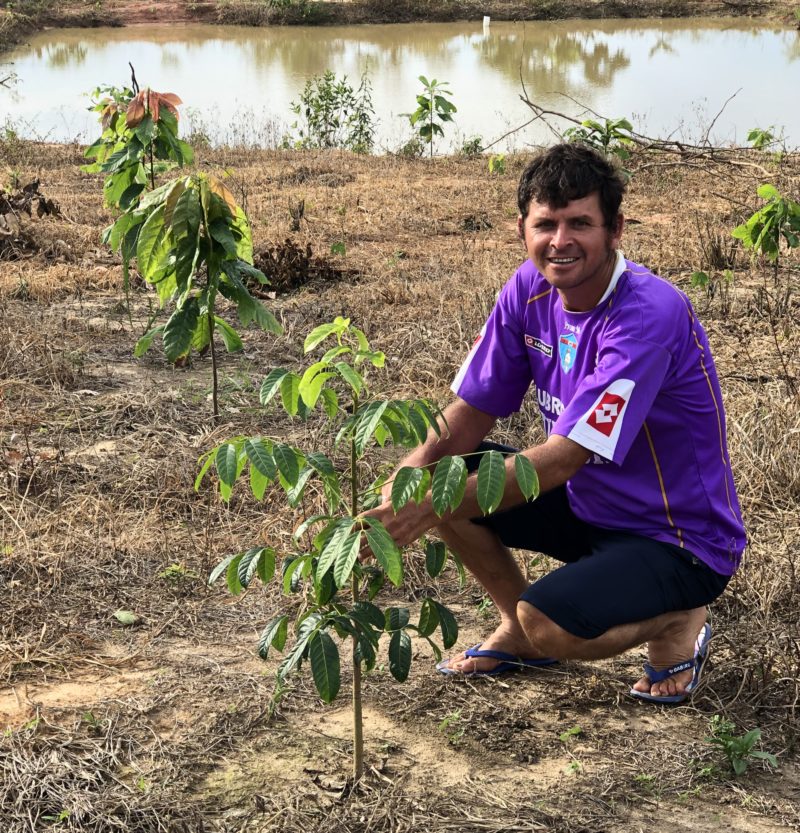The importance of sustainable farming

Photo: Smallholder farmer, Hugo, showing one of his recently planted Shihuahuaco trees — a native timber. Behind, you can see the cocoa trees that are growing alongside.
Each year, a staggering 160,000 hectares are cut down in the Peruvian Amazon Rainforest, often to make room for permanent agricultural land. That’s equivalent to 160,000 football fields -— a sobering thought indeed.
The most common driver of deforestation in Peru remains subsistence agriculture. Local people cut down the rainforest simply as a way to survive. Subsistence agriculture occurs when families who live on the land clear the rainforest to sow crops and graze animals, growing food to feed themselves and make just enough money to live. Farm output is very much targeted towards survival and is mostly for local requirements with little to no surplus trade.
The most common technique in Peru used to covert forests for subsistence farming by smallholder farmers is known as slash-and-burn. The method involves the cutting and burning of plants in a forest or woodland to create a field to grow crops. The trees and downed vegetation or “slash” is first left to dry. A few weeks later this dry material is burned to get rid of the larger trunks and branches, creating space for planting crops.
The consequences of slash-and-burn can be devastating, negatively impacting climate change, soil erosion and degradation, watershed degradation and loss of biodiversity, and it’s not just taking place in the Peruvian Amazon. Tropical forests across Asia, Africa and Latin America are all being rapidly transformed through slash-and-burn.
So why is slash-and-burn taking place at all?
Many families in Peru live in poverty. Faced with little alternative to earn an income and feed their families, they farm to survive. Given the shortage of funds and support, this is done in a basic and low-tech manner — where the farmers clear the land and plant crops with the immediate term in mind. While this works better in temperate environments like the UK, France, New Zealand etc, the land in the tropics (around the equator) is characterised by heavy rains and hot sun, which is not well suited to this type of farming.
Why is that? Sadly, without the protective cover of trees, the Amazonian soils are unable to support crop growing or cattle grazing for more than a few years. Soils are washed away by heavy rain and nutrients are removed meaning that fertility is quickly lost, leaving the land unable to support crops or cows. This means farmers can only grow crops on their land for one or two years before it becomes unproductive and they have to move on to another patch of rainforest to start all over again. It is this constant need to find and farm new land that is driving the majority of the deforestation in Peru.
Aside from the effect of cutting down trees on soil fertility, deforestation is also having a negative impact on the local climate. In areas like Ucayali where Plant Your Future works and where there is a naturally more pronounced dry season, the hot and dry climate in summer is now even more noticeable. Without the cooling impact of trees that create clouds via evapotranspiration through their leaves, there is a heightened risk of intense droughts and wildfires. Similarly, in the wet season in Loreto, the deforestation means that there are less trees to take up the rain. Consequently, flooding can be much worse, meaning houses and land that never used to be under threat are now at risk.
Luckily there is a solution, in the form of improved agroforestry systems. Simply put, agroforestry is the practise of farming which combines trees and crops — it is agriculture and forestry in the same place! With the right training, farmers gain the skills, inputs and learn the techniques required to put long-term, sustainable practises into place. The key lies in diversifying their revenue streams.
Plant Your Future works to put resources and knowledge into the hands of smallholder farmers. Through support and education, farmers are able to put a more sustainable form of tree-based agriculture into place, which combines planting crops, fruit-bearing orchard trees (e.g. cocoa trees) and timber trees, all of which are better suited to the soils of the rainforest ecosystem.
Diversity of revenue is achieved through long-term returns from the trees and short-term returns from the crops that can be grown in the spaces between them, such as chilli peppers or cocoa. With short-term income generated from a sustainable source, farmers can focus on one area for many years. There’s no longer any need to clear more rainforest through techniques such as slash-and-burn, as farmers are already generating an adequate income from their agroforestry systems. The cocoa market in Peru in particular is growing with international demand for chocolate on the rise, providing an interesting opportunity for smallholders.
We have also identified chilli peppers as a particularly profitable revenue stream for our farmers. Unlike other short-term crops, chilli peppers can produce continuously with new fruit crops to harvest every 20 days. If you want to show your support, you can make a donation that will help us support new farmers to move from slash-and-burn to sustainable agroforestry today. Please visit:
https://www.plantyourfuture.org.uk/donate/
Written by Chloe Tonkin, PR Volunteer for Plant Your Future
agroforestry, amazon rainforest, chilli peppers, deforestation, sustainable farming